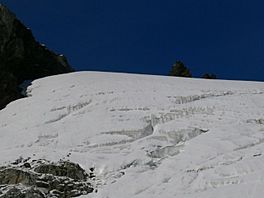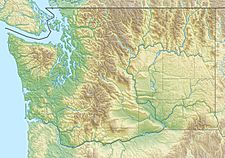Sahale Glacier facts for kids
Quick facts for kids Sahale Glacier |
|
|---|---|

Sahale Glacier
|
|
| Type | Mountain glacier |
| Location | North Cascades National Park, Chelan County, Washington, U.S. |
| Coordinates | 48°29′15″N 121°02′30″W / 48.48750°N 121.04167°W |
| Length | .25 mi (0.40 km) |
| Terminus | Icefall/barren rock |
| Status | Retreating |
Sahale Glacier is a cool, icy river of frozen snow and ice found high up in the North Cascades National Park in Washington. It's like a giant, slow-moving ice cube on the side of Sahale Mountain. This glacier is an important part of the park's natural beauty and helps us understand how our planet is changing.
Contents
What is a Glacier?
A glacier is a huge, long-lasting body of ice. It forms over many years from layers of snow that get packed down tightly. Glaciers move very slowly, like a super-slow river of ice. They can be found in high mountains or near the Earth's poles.
Where is Sahale Glacier?
Sahale Glacier is located in the North Cascades National Park. This park is in the state of Washington in the U.S.. The glacier sits on the south side of Sahale Mountain. Imagine looking at the mountain; the glacier is on the sunny side, facing south.
Its Neighbors
Sahale Glacier isn't alone! It has other glaciers nearby. To its northeast, you'll find the Davenport Glacier. To the north, there's the Quien Sabe Glacier. These glaciers are separated from Sahale by rocky ridges, which are like natural walls.
Size and Shape
Sahale Glacier is about 0.25 mi (0.40 km) long. That's about a quarter of a mile! It stretches down the mountain from a height of about 8,200 ft (2,500 m) to 7,800 ft (2,400 m). This means it flows downhill, just like water, but much, much slower.
Retreating Ice
Sadly, Sahale Glacier is currently "retreating." This means it's getting smaller and shrinking back. Many glaciers around the world are retreating because of changes in our planet's climate. When a glacier retreats, it leaves behind bare rock where ice used to be.
Why Glaciers are Important
Glaciers are more than just big chunks of ice. They are important for several reasons:
- Water Supply: Many glaciers melt slowly during warmer months, providing fresh water for rivers and streams. This water is used by people, animals, and plants.
- Wildlife Homes: Some animals, like certain types of fish and insects, depend on the cold water from glaciers to survive.
- Climate Clues: Scientists study glaciers to learn about Earth's past climate. The ice holds clues about temperatures and air quality from hundreds or even thousands of years ago.
- Beautiful Landscapes: Glaciers carve out amazing valleys and mountains, creating stunning natural scenery that people love to visit.


